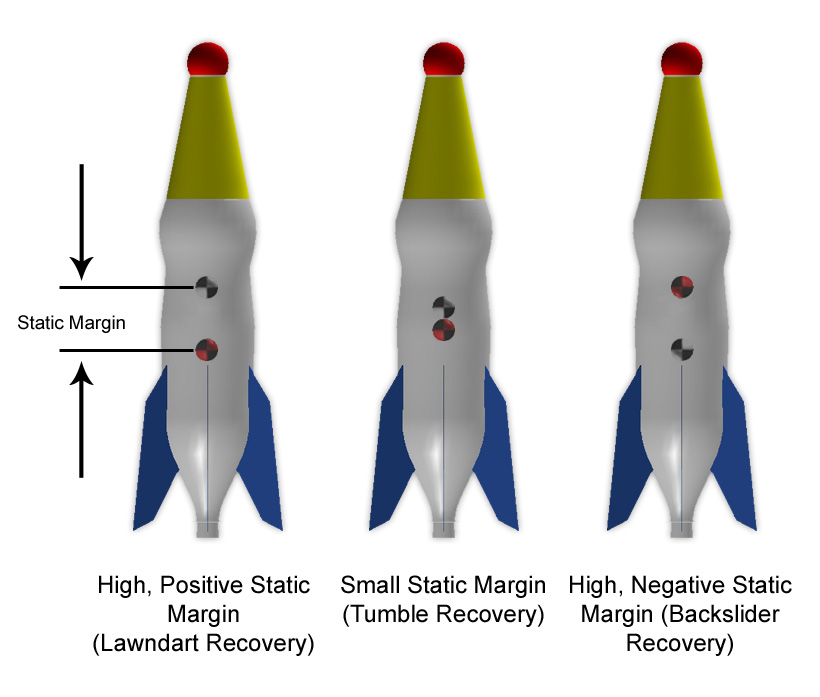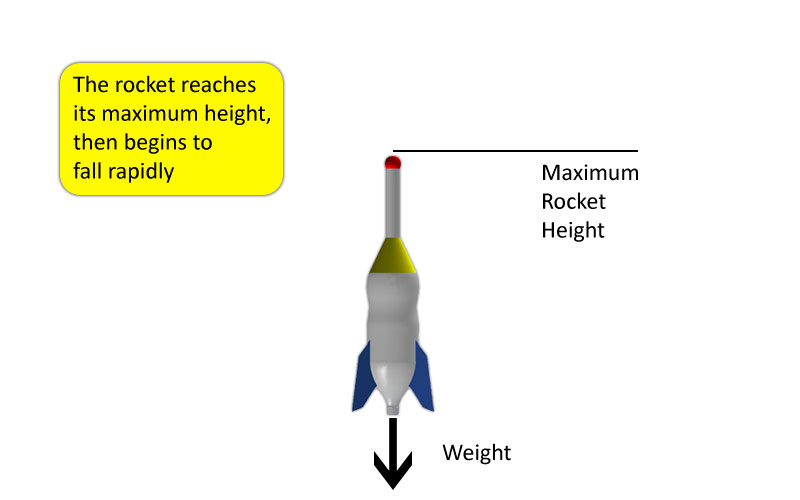Recovery System
A recovery system is part of the rocket that allows the rocket to safely return to earth after launch. There are many different types of recovery systems, but we will focus on the types available in the Rockets application: Standard or "Lawndart", tumble, backslider, and a parachute. The parachute is an active recovery system, and the others are all considered passive recovery systems.
Passive Recovery System
The standard (lawndart), tumble, and backslider recovery systems are considered passive designs because the rocket's return to earth is largely based on the same principles of stability that took the rocket upwards. In other words, there is no system that "kicks in" at the right time to safely bring the rocket back to earth. So to understand how these passive recovery systems work, we need to consider each in the context of stability - specifically the static margin.

Passive Recovery Designs
- The first is a lawndart. The rocket reaches its maximum altitude, then rotates and falls nose first back to earth. The lawndart works due to high positive static margin, meaning that the center of gravity is closer to the nose than the center of pressure. The center of gravity always falls first, thus the nose will impact the ground first with a lawndart recovery system. Due to the rocket having relatively low drag, the rocket falls quickly and the nose takes a relatively high impact onto the ground.
- The second passive recovery is tumbling. The rocket reaches a maximum altitude, then proceeds to tumble, spinning and rotating back to earth. Tumbling works due to a small positive or negative static margin. The rocket's drag is increased due to the way it is falling, slowing the decent. However, any part of the rocket may impact the earth.
- The third is backsliding. The rocket reaches maximum altitude, then falls tail, rear, or nozzle end first back to the earth. The backslider works due to a high negative static margin, meaning that the center of pressure is closer to the nose than the center of gravity. Again, the center of gravity falls first and since the center of gravity is closer to the tail, the tail impacts the ground first. The rocket falls relatively quickly and the tail takes a high impact into the earth.
In general passive recovery systems are simple, lightweight, inexpensive, and reliable. However, they often have a high speed return, are more dangerous, are not suitable for fragile payloads, and if not done correctly can cause substantial damage to the rocket.
Active Recovery System
Active recovery systems tend to be better for heavier rockets, and provide a safer recovery. However, active recovery systems are often more complex, have a higher chance of failure, and add weight to the rocket.
The parachute is an active recovery system. When the rocket reaches maximum altitude, gravity causes it to begin its descent back to earth. Since the ping pong ball is not attached firmly and is itself a high drag shape, the ball descends more slowly than the rest of the rocket, thus pulling the parachute out. The parachute then opens and produces extra drag which slows the rocket's descent even more. Thus, the parachute increases total flight time.
The following animation provides additional information on how the parachute recovery system works. Click the blue "Next Slide" button to go to the next slide.

Rules For a Working Parachute
Prior to launch, the parachute and string are placed inside of the nose cone tube. The string is then attached to the ping pong ball. If the parachute works properly, the ping pong ball will descend more slowly than the rocket and pull the parachute out of the tube. At times, however, the parachute will fail to deploy. This can happen for one of two reasons:
- The space inside of the nose cone tube may be too small. Look for items in the Recovery system work area called Deploy Volume and Tube Volume. If the tube volume (what you have actually designed) is less than the required deploy volume, then the parachute will not deploy. (Basically, the parachute is crammed into such a small space that it sometimes will not come out). If this happens, you should increase your actual tube volume by selecting a tube with a larger radius, or increasing the length of the tube.
- The mass of the ping pong ball may be too small. This is related to the issue described above in that the parachute needs to be pulled out of a small area. Adding clay to the ball will increase its mass and provide more force to pull the parachute out of the nose cone tube. If you use a parachute, you will need to add a minimum of 20 g of clay to the nose to help pull the parachute.
Action Items
You should design your recovery system to minimize the falling velocity of the rocket. Since drag depends on velocity, drag increases until the drag force is equal to weight. When the drag force and weight are equal the rocket has reached "terminal velocity". Use the following animation to see how weight and parachute size - the two independent variables that you can control - will affect terminal velocity.